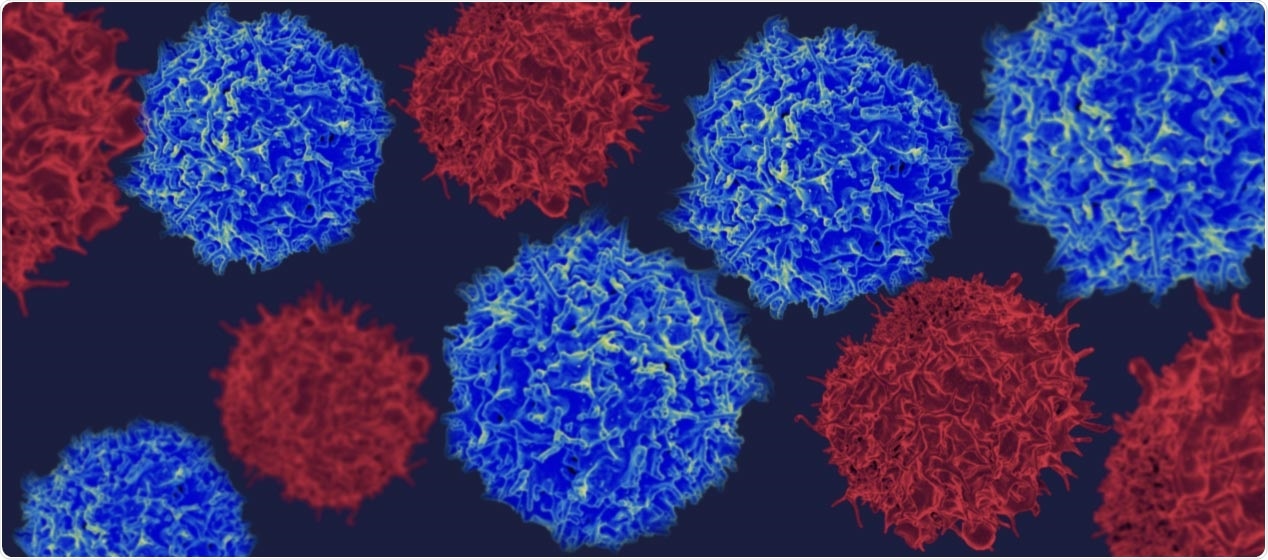Researchers have found that immune T cells exhibit a range of responsiveness. This finding could offer insights into how the immune system of humans responds to infections and cancer, and what goes wrong in immune diseases.

There is a whole spectrum of T cell memory experience and this not only affects how far a cell can respond but also what signals it can respond to. Image Credit: NIH NIAID
At Wellcome Sanger Institute, Biogen, Open Targets, and GSK, researchers and their colleagues have identified that T cells respond to immune signals in a highly distinctive way the more “training” they undergo, rather than experiencing a simple shift from naive to experienced. This could enable studies to find drug targets for immune diseases like asthma and rheumatoid arthritis.
In a study published in Nature Communications, the researchers have reported that even highly trained memory T cells are not so robustly specialized than considered earlier and have the ability to respond to new immune signals.
The study has implications for immune research and could offer insights into how the body responds to infections.
T cells are important white blood cells that combat infection and disease. They play a vital role in regulating the immune system response. Babies are born with inexperienced, or naive, T cells that change as they encounter bacteria or viruses to synthesize particular memory T cells with the ability to “remember” to fight against such infections.
Eventually, these memory T cells can react more swiftly upon encountering the same threat next time; thus, the immune system is directed to remove the infection quickly. This is how vaccinations are used for protecting against disease by releasing a safer form of an invading bacterium or virus to prepare ones’ immune system to create specific memory T cells.
Deficiency in T cells can cause severe immune deficiencies, making people vulnerable to infections. On the other hand, in autoimmune diseases like type 1 diabetes and rheumatoid arthritis, the body can misunderstand some of its own cells as a threat and turn on an improper immune response that makes the body attack itself.
Researchers collected blood from healthy volunteers and analyzed their T cells to gain an insight into the formation of memory T cells and their response during disease. They identified the genes that were precisely turned on in each individual T cell, which indicates the activity of the cell.
In addition, these T cells were tested against different immune molecules called cytokines, to simulate how they might act within the body.
The team found that rather than having a simple shift, from naive to memory cell, there was a whole continuum of T cell development. They showed that the more often a T cell is activated by a signal, the more it shifts along the line of memory T cell development—its “training”—and the faster it could respond to that particular signal.
Previously people thought that memory T cells had two stages of development, but we discovered there is a whole spectrum of memory experience. From naïve T cells that have never been activated, to highly trained memory T cells which can react quickly, and many intermediate T cells in between. This spectrum not only affects how fast a cell can respond, but even what signals it can respond to.”
Eddie Cano Gamez, Study First Author, Wellcome Sanger Institute and Open Targets
The research revealed that the T cells also exhibited a continuum of responsiveness to other chemical signals, indicating they were less specialized than considered earlier. It was identified that even highly trained memory T cells could be activated by the other, new immune signals.
Some signals were found to produce highly distinct responses in memory cells, based on their experience level.
Upon adding a specific chemical signal—such as the transforming growth factor (TGF)—to naive T cells, they responded by synthesizing regulatory T cells to calm down the immune system. But the same chemical had a reverse effect on experienced memory cells, causing them to release more chemicals, which leads to inflammation.
The collaboration of researchers at the Sanger Institute, Biogen GSK, and other Open Targets partners will enable the study results to be translated into novel treatments.
We were surprised to see how flexible and complex the memory T cells’ response could be. Understanding this varied T cell response could help us understand our response to infections such as viruses, and also give clues to what is going wrong in immune diseases such as asthma and type 1 diabetes. By understanding the pathways involved in normal immune response, we aim to find better drug targets for developing new medicines.”
Dr Gosia Trynka, Study Senior Author, Wellcome Sanger Institute and Open Targets
Source:
Journal reference:
Cano-Gamez, E., et al. (2020) Single-cell transcriptomics identifies an effectorness gradient shaping the response of CD4+ T cells to cytokines. Nature Communications. doi.org/10.1038/s41467-020-15543-y.